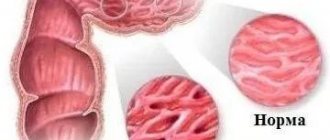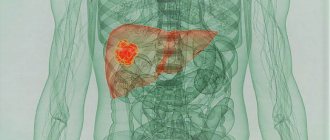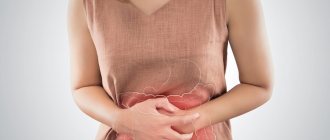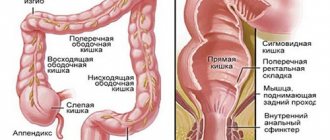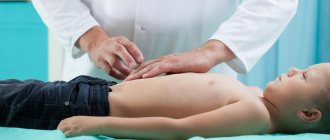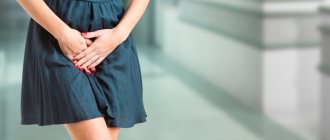Types of colitis
There are two types of colitis: acute and chronic. The disease usually begins with an acute form with characteristic pain, flatulence and nausea. But prolonged acute colitis can cause the development of a chronic form of the disease.
Chronic colitis is characterized by the presence of pathological changes in the structure of the intestinal mucosa. The cause of these changes is a prolonged inflammatory process, which leads to degeneration of the affected tissues and dysfunction of the large intestine. Often inflammation of the large intestine can cause damage to the small intestine.
Colitis is also divided into several types depending on the causes of the disease:
- infectious colitis is associated with infectious diseases;
- nutritional problems arise due to malnutrition;
- toxic exogenous colitis caused by poisoning with harmful substances;
- endogenous colitis is observed due to intoxication with catabolic products;
- drug colitis develops under the influence of drugs;
- allergic colitis becomes an allergic reaction of the body to pathogens;
- Mechanical colitis is the result of regular mechanical irritation of the intestinal mucosa.
In some cases, inflammation of the large intestine can be caused by several factors. Then doctors diagnose combined colitis.
Publications in the media
Pseudomembranous colitis is an acute, severe disease of the colon that develops as a complication of antibacterial therapy. Incidence • In the general population - 6.7:100,000 treated with antibiotics • Clostridium difficile is found in 10-20% of inpatients • Predominant age - 40-75 years.
Etiology - Clostridium difficile The carriage rate among the adult population is 2-3%.• Clostridium difficile reproduction conditions - anaerobic environment and inhibition of the growth of normal intestinal microflora. The disease develops when Clostridium difficile becomes resistant to antibiotics that suppress the activity of other intestinal microflora. The lack of competition contributes to the accelerated proliferation of Clostridium difficile and the release of toxins • The most common causes of colitis are clindamycin, lincomycin, ampicillin, penicillin, cephalosporins, tetracycline, erythromycin. The method of administration of the antibiotic does not matter. When taken orally (in addition to the effect on the microflora), the antibiotic has a local effect directly on the intestinal wall.
Risk factors • Long-term use of antibiotics • Chemotherapy - fluorouracil, methotrexate, combination drugs • Intestinal surgery • Uremia • Intestinal ischemia • Bone marrow transplantation.
Clinical picture • Symptoms usually develop from 3 days to 4 weeks from the start of antibacterial therapy • Watery diarrhea with an unpleasant odor; rarely - with an admixture of blood (in case of development of erosive-hemorrhagic changes in the intestinal mucosa). The frequency of stool may increase even after stopping the etiologically significant antibiotic. Cramping pain in the lower abdomen, mainly in the projection of the large intestine, after defecation • Fever (with an increase in body temperature to 38 ° C). Dehydration and electrolyte disturbances are a sign of severe disease. Toxic megacolon and colonic perforation are rare but serious complications requiring surgical intervention.
Diagnostics
• Analysis of peripheral blood •• Leukocytosis, shift of the leukocyte formula to the left •• Hypoalbuminemia.
• Confirmation of the presence of Clostridium difficile •• Bacteriological examination of stool with the determination of Clostridium difficile toxin in it - the test for the toxin is considered positive if a cytopathic toxin neutralized by a specific antitoxin is identified during tissue culture testing; the frequency of positive results is 20–90% depending on the severity. Diagnostics of intestinal dysbiosis - gas chromatography and mass spectrometry - reveal significant changes in the composition of normal microflora in the direction of increasing the concentration of various microorganisms; total colonization of the mucous membrane increases 2-5 times compared to the norm.
• Colonoscopy - the presence of yellow-white plaque-like “membranes” of fibrin, leukocytes and rejected necrotic epithelial cells, soft but tightly adherent to the mucous membrane. The changes are most pronounced in the distal parts of the colon and rectum •• A characteristic sign is the preservation of areas of the mucous membrane under pseudomembranous overlays, in the form of bridges spreading between the affected areas. The mucous membrane is swollen, but not ulcerated. Bleeding may occur when attempting to remove the pseudomembrane. Histological examination may have diagnostic value. Although, based on its results, it is not always possible to distinguish the picture of pseudomembranous colitis from ulcerative or ischemic.
• Plain radiography of the abdominal organs: bloating of the colon • Irrigography •• Jaggedness of the contours of the colon, associated with ulceration of the mucous membrane or the presence of pseudomembranes, between the convex surfaces of which barium suspension flows •• Swelling of the intestinal wall, expansion of folds, disruption of haustration.
Differential diagnosis • Nonspecific ulcerative colitis • Crohn's disease • Ischemic colitis • Irritable bowel syndrome • Colitis of infectious etiology.
Management tactics • Cancellation of antibiotics that caused the disease, except when they are prescribed for health reasons • Etiotropic therapy aimed at eliminating Clostridium difficile. Vancomycin 125 mg 4 times a day orally for 7-10 days, if necessary, the dose can be increased to 500 mg 4 times a day. Metronidazole 500 mg 2 times a day orally or intravenously for 7–10 days • Correction of metabolic disorders and water-electrolyte balance.
Bacterial therapy - the use of high doses of probiotics (bififorms, bifidobacterium bifidum, etc.) or bacterial mixtures that are similar to human fecal flora; it is possible to administer drugs using enemas based on saline solutions, through a nasoduodenal tube or through a colonoscope. The effect is due to the bactericidal effect of fecal flora, which leads to the elimination of symptoms of the disease in more than 95% of patients with diarrhea associated with Clostridium difficile.
Surgery. In case of severe complications (perforation or acute toxic dilatation of the colon), a total colonectomy or unloading ileostomy is necessary.
Complications • Toxic dilatation of the colon • Perforation of the colon • Severe malabsorption syndrome.
Flow. The course is favorable in case of timely recognition of the disease, discontinuation of the antibiotic that caused diarrhea, and adequate treatment.
Synonyms • Pseudomembranous enterocolitis • Mucosal colic • Intestinal mucosal colic • Pseudomembranous colic • Membranous colitis • Mucomembranous colitis • Mucosal colitis
ICD-10 • A04.7 Enterocolitis caused by Clostridium difficile.
Symptoms of intestinal colitis
With chronic colitis, the patient feels pain in the abdomen, often on the left, but sometimes it is not possible to localize the source of the pain. The pain intensifies after eating and decreases after defecation. A feeling of heaviness in the abdomen, bloating and flatulence are possible. A characteristic symptom of colitis is stool disorder with mucus and blood in the stool. Constipation may be replaced by diarrhea; the patient often feels the “urge” to defecate without excreting feces.
Colitis may also be accompanied by more “general” symptoms that are not directly related to the gastrointestinal tract, such as fever, weakness and joint pain. The patient loses his appetite, which leads to weight loss. If colitis is accompanied by acute inflammatory processes, then all clinical symptoms appear more clearly.
Causes of mucous colitis
Having identified the causes of mucous colitis, specialists prescribe treatment. It is always conservative and consists of reducing irritation, including eliminating the factor that provokes relapse of the disease. For this purpose, antispasmodics and drugs that relax the intestinal muscles are prescribed. It is necessary to reduce flatulence, which leads to dysfunction of the digestive system.
Treatment of the inflammatory process is impossible without meeting several requirements:
- nutrition should be rational, contain the required amount of proteins and carbohydrates;
- Flour products and products that cause increased gas formation are excluded from the diet;
- the patient must avoid stressful situations and give up alcohol.
When symptoms disappear, therapy does not stop. It is necessary to completely eliminate the irritating factor and undergo control diagnostics. Complete recovery occurs after a course of probiotics and normalization of microflora.
Diagnosis of colitis
Colitis is diagnosed as a result of a whole range of tests. This includes: macro and microscopy of stool, general blood test, contrast irrigoscopy and colonoscopy. These tests make it possible to detect the presence of helminth eggs, inflammation, and also to study the anatomical and functional features of the large intestine and the condition of the colon mucosa. During a colonoscopy, samples are taken for further histological examination. A proctologist also examines the patient; he examines the anus to exclude the possibility of hemorrhoids, paraproctitis and other pathologies.
Intestinal dysfunction can be complicated by inflammation. In addition, colitis may not be the main disease, but accompany the development of a colon tumor. Therefore, doctors take a biopsy of suspicious areas of the intestinal wall to conduct additional tests and exclude the possibility of malignant neoplasms. If enteritis or other diseases are suspected, a number of diagnostic procedures may be prescribed, for example, an ultrasound of the abdominal organs and functional tests to identify markers of inflammation of the liver and pancreas.
Manifestations of the disease
Ulcerative colitis is characterized by a wide variety of clinical manifestations. The Montreal classification helps to systematize manifestations (Table 1). According to it, it is possible to assess the characteristics of the course of the disease, the extent of the lesion, the severity of the attack and the presence of complications.
| Proctitis | The lesion is limited to the rectum |
| Left-sided colitis | The lesion extends to the left flexure of the colon (including proctosigmoiditis) |
| Total colitis | (Including subtotal colitis, as well as total UC with retrograde ileitis) |
Table 1. Montreal classification of ulcerative colitis by extent of lesion.
The course of ulcerative colitis is characterized by three options:
- Acute course (less than 6 months from the onset of the disease). It can occur with a fulminant (quick) or gradual onset.
- Chronic continuous course, which is characterized by the absence of more than 6-month periods of remission against the background of adequate therapy.
- Chronic relapsing course (presence of more than 6-month periods of remission). It can be either rarely recurrent (once a year or less) or frequently recurrent (2 or more times a year).
The presence of extraintestinal manifestations, the development of complications, the intensity and severity of the current exacerbation and the emergence of resistance to treatment in the patient (for example, hormonal dependence) determines the severity of ulcerative colitis.
The severity of the current exacerbation or attack is also used to create a treatment plan and formulate a diagnosis. In clinical practice, the Truelove-Witts criteria and the disease activity index (Mayo index) are used for this purpose. There are three levels of attack: light, medium, heavy.
The course of ulcerative colitis has periods of exacerbation (relapse) and remission.
Relapse (exacerbation or attack) is characterized by the appearance of symptoms of the disease against the background of remission, which was achieved through medication or occurred spontaneously. If a relapse occurs less than 3 months after remission, then it is considered early. Signs of relapse: an increase in the frequency of bowel movements with the release of blood, as well as changes in the colon mucosa, which are found during endoscopic examination.
Remission of ulcerative colitis involves healing of the colon mucosa in the absence of the main symptoms of the disease.
Treatment of intestinal colitis
Treatment for colitis depends on its type. Chronic colitis during periods of exacerbation is best treated in a hospital proctology department. If the cause of colitis is an infection, then it will be treated in the infectious diseases department.
A proper diet plays an important role in the treatment of colitis; it is also prescribed by a doctor. The patient's diet should not contain foods that can mechanically or chemically irritate the intestines, for example, fermented milk products. The patient will have to take food in pureed form, in small portions and at least 4-5 times a day. You will also have to give up foods that contribute to gas formation, for example, cabbage and legumes.
Lightly dried unsweetened wheat bread, lean meat and fish are allowed. It is better to steam food. As the patient's condition improves, the list of permitted products is increased.
If the nature of the disease was infectious, then the treatment will be a course, medications for antibacterial therapy will be prescribed by the doctor. For any form of colitis, moderate physical activity and physical therapy are useful.
Prevention of colitis
A good preventative measure to prevent the occurrence of colitis is a balanced diet. Proper nutrition will minimize the risk of various gastrointestinal diseases. It is recommended to exclude the consumption of alcohol, spices, canned food, and switch to fractional meals.
People with diagnosed chronic diseases of the large intestine should be under the supervision of specialists and undergo periodic medical examinations. It is better for them to avoid excessive physical activity and stress, not work at night and monitor their sleep patterns.
Even if you have not suffered from colitis before, no one is immune from this disease. Timely diagnosis and proper treatment of the disease are important, so undergo regular preventive examinations and consult a doctor at the first symptoms of colitis. Do not experiment with self-medication; drug abuse can only harm you.

